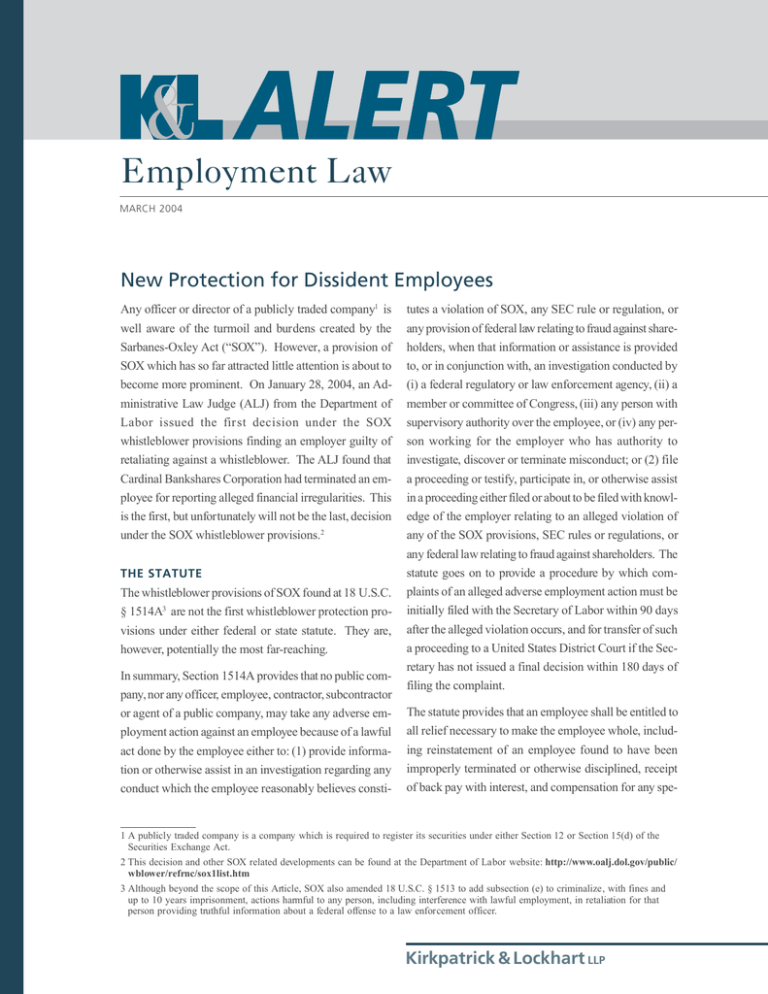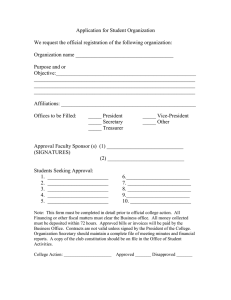
Employment Law
MARCH 2004
New Protection for Dissident Employees
Any officer or director of a publicly traded company1 is
well aware of the turmoil and burdens created by the
Sarbanes-Oxley Act (“SOX”). However, a provision of
SOX which has so far attracted little attention is about to
become more prominent. On January 28, 2004, an Administrative Law Judge (ALJ) from the Department of
Labor issued the first decision under the SOX
whistleblower provisions finding an employer guilty of
retaliating against a whistleblower. The ALJ found that
Cardinal Bankshares Corporation had terminated an employee for reporting alleged financial irregularities. This
is the first, but unfortunately will not be the last, decision
under the SOX whistleblower provisions.2
THE STATUTE
The whistleblower provisions of SOX found at 18 U.S.C.
§ 1514A3 are not the first whistleblower protection provisions under either federal or state statute. They are,
however, potentially the most far-reaching.
In summary, Section 1514A provides that no public company, nor any officer, employee, contractor, subcontractor
or agent of a public company, may take any adverse employment action against an employee because of a lawful
act done by the employee either to: (1) provide information or otherwise assist in an investigation regarding any
conduct which the employee reasonably believes consti-
tutes a violation of SOX, any SEC rule or regulation, or
any provision of federal law relating to fraud against shareholders, when that information or assistance is provided
to, or in conjunction with, an investigation conducted by
(i) a federal regulatory or law enforcement agency, (ii) a
member or committee of Congress, (iii) any person with
supervisory authority over the employee, or (iv) any person working for the employer who has authority to
investigate, discover or terminate misconduct; or (2) file
a proceeding or testify, participate in, or otherwise assist
in a proceeding either filed or about to be filed with knowledge of the employer relating to an alleged violation of
any of the SOX provisions, SEC rules or regulations, or
any federal law relating to fraud against shareholders. The
statute goes on to provide a procedure by which complaints of an alleged adverse employment action must be
initially filed with the Secretary of Labor within 90 days
after the alleged violation occurs, and for transfer of such
a proceeding to a United States District Court if the Secretary has not issued a final decision within 180 days of
filing the complaint.
The statute provides that an employee shall be entitled to
all relief necessary to make the employee whole, including reinstatement of an employee found to have been
improperly terminated or otherwise disciplined, receipt
of back pay with interest, and compensation for any spe-
1 A publicly traded company is a company which is required to register its securities under either Section 12 or Section 15(d) of the
Securities Exchange Act.
2 This decision and other SOX related developments can be found at the Department of Labor website: http://www.oalj.dol.gov/public/
wblower/refrnc/sox1list.htm
3 Although beyond the scope of this Article, SOX also amended 18 U.S.C. § 1513 to add subsection (e) to criminalize, with fines and
up to 10 years imprisonment, actions harmful to any person, including interference with lawful employment, in retaliation for that
person providing truthful information about a federal offense to a law enforcement officer.
Kirkpatrick & Lockhart LLP
cial damages, including litigation costs, expert witness
fees and reasonable attorney’s fees. The statute does not
on its face provide for damages for emotional distress,
etc., nor does it provide for the award of punitive damages.4 Finally, the statute provides that the employee’s
rights under SOX are in addition to any other rights the
employee may have under federal or state law.
THE REGULATIONS
The interim final regulations issued by the Secretary of
Labor to implement the SOX whistleblower provisions
are found at 29 C.F.R. Part 1980. It is not the purpose of
this article to review these regulations in detail, but rather
to provide a broad overview of the enforcement mechanism set forth in the regulations and to comment upon
some aspects of the statute and regulations.
Under the regulations, the accused is referred to as the
“named person,” and the named person may be one or
more individuals, most likely supervisors and other senior management officials, as well as the company.
Accordingly, individual company representatives, as well
as the company itself, may be personally liable for damages.
The Secretary of Labor has opted to use the administrative procedures already in place to receive and process
whistleblower complaints under the Occupational Safety
and Health Act (OSHA). Thus, complaints under SOX
are filed with the OSHA Area Director and processed by
the Assistant Secretary of Labor for Occupational Safety
and Health (the “Secretary”).
Upon receipt by the Secretary of a complaint filed within
90 days of the adverse employment action, the named
person(s) is notified, with a copy of the notice also sent to
the SEC. The Secretary will dismiss the complaint if a
prima facie case is not made by the complainant. Even if
a prima facie case is made, within 20 days of receipt of
notice, the named person may submit evidence and/or
meet with the Secretary to convince the Secretary by clear
and convincing evidence that the adverse employment
action would have been taken even in the absence of the
protected activity. If the Secretary is not convinced, an
investigation is conducted. If the Secretary preliminarily
finds reasonable cause to believe a violation has occurred
and that preliminary reinstatement is warranted, the named
person is given an opportunity within 10 business days
to provide written evidence and response to the reasonable cause conclusion.
The Secretary must make a final decision within 60 days
of filing the complaint whether or not reasonable cause
exists to believe that a violation has been shown. If the
Secretary finally concludes that reasonable cause exists,
the Secretary will issue findings and a preliminary order
for relief. The order for relief may include a preliminary
reinstatement of the employee or, in the alternative, an
order that the employee receive the same pay and benefits he received prior to termination, but not actually
return to work pending final resolution. The employer
has 30 days from receipt of the preliminary findings to
request a hearing before an ALJ. The preliminary reinstatement is effective immediately if ordered.
If the Secretary concludes that there has been no violation, the named person may request that attorney’s fees
up to $1,000.00 be assessed against the complainant if
the complaint was frivolous or brought in bad faith.
The regulations contemplate that if a finding and preliminary order against a named person is issued, the
complainant will in most instances be responsible for prosecuting the complaint, although the Secretary has the
discretion to participate either as a party or as
amicus curiae at any time in the administrative proceedings, and the SEC at its discretion may also participate as
amicus curiae.
Because of the complainant’s opportunity to remove the
action to federal court if a final decision is not issued
within 180 days after the complaint is filed, the regulations provide that the hearing before the ALJ will be held
quickly, and discovery may be limited.
4 The regulations (29 C.F.R. § 1980.109) also do not appear to provide for emotional distress or punitive damages, but claimants’
attorneys will probably seek such damages as “special damages” until the issue is resolved.
2
KIRKPATRICK & LOCKHART LLP EMPLOYMENT LAW ALERT
A named person or the complainant adversely affected
by the ALJ’s decision may petition for discretionary review by the Department of Labor’s Administrative Review
Board within 10 business days after receipt of the adverse
decision. All relief except preliminary reinstatement is
stayed pending review. The Board has 30 days in which
to decide whether to grant the petition for review. If it
does not grant review, the decision of the ALJ becomes
the final decision of the Secretary. If the Board grants
review, it must issue a decision not later than 120 days
after the conclusion of the ALJ proceedings, which conclusion normally will be 10 days after the date of the
Administrative Law Judge’s decision. The final decision
may be appealed to the appropriate United States Court
of Appeals.
An unusual feature of SOX is the short time period
(180 days after the filing of the complaint if the complainant has done nothing to delay the process) within
which the Secretary must issue a final decision, and the
right of the complainant to file an action in United States
District Court after that time if the final decision has not
issued. Thus, even though a hearing may have been held
before an ALJ, a decision for or against the named person issued, or a petition for review pending before the
Review Board, the complainant may (but is not required
to) terminate this proceeding after 180 days by filing an
action in United States District Court.
The effect of this right to file in District Court may result
in the complainant getting two chances to win the case.
Thus, if the complainant believes that he or she will lose
at some point during the administrative procedure, or if
the complainant prefers a trial before a judge and jury,
and if the case is not finally resolved within 180 days, the
complainant may take the case to District Court. If that is
done, it remains to be seen to what extent a District Court
may give res judicata or collateral estoppel effect to interim decisions by the Secretary of Labor.
MARCH 2004
CONCLUSIONS
It is too early to draw conclusions as to how this new
legislation will play out. However, some preliminary
observations are appropriate:
1. The 180-day time period for final administrative action is extremely short when dealing with complex
financial matters.
2. The personal liability of an officer or employee listed
as a named person raises serious issues of indemnity
by the company as well as opportunities for vindictive action by a complainant.
3. Preliminary reinstatement, if ordered, of a complainant will cause procedural and personnel problems.
4. The apparent lack of availability of damages for mental or emotional distress or punitive damages reduces
the potential exposure.
5. The potential $1,000.00 recovery of attorney’s fees
by a named person if a determination is made that a
complaint has not been filed in good faith is clearly
insufficient.
6. As any employer who has been forced to very carefully deal with any employee who has placed himself
or herself under a protective statute, or who has filed a
discrimination claim under a statute, knows, the potential for abuse by a poorly performing or dissident
employee is substantial.
HAYES C. STOVER
hstover@kl.com
412.355.6476
Kirkpatrick & Lockhart LLP
FOR MORE INFORMATION, please contact one of the following K&L lawyers:
Boston
Henry T. Goldman
617.951.9156
hgoldman@kl.com
Dallas
Jaime Ramón
214.939.4902
jramon@kl.com
Harrisburg
Carleton O. Strouss
717.231.4503
cstrouss@kl.com
Los Angeles
Thomas H. Petrides
310.552.5077
tpetrides@kl.com
Paul W. Sweeney, Jr.
310.552.5055
psweeney@kl.com
Miami
Daniel A. Casey
305.539.3324
dcasey@kl.com
Newark
Marilyn Sneirson
973.848.4028
msneirson@kl.com
New York
David R. Marshall
212.536.4066
dmarshall@kl.com
Rory J. McEvoy
212.536.4804
rmcevoy@kl.com
Pittsburgh
Stephen M. Olson
412.355.6496
solson@kl.com
Michael A. Pavlick
412.355.6275
mpavlick@kl.com
Hayes C. Stover
412.355.6476
hstover@kl.com
San Francisco
Jonathan M. Cohen
415.249.1029
jcohen@kl.com
Washington
Lawrence C. Lanpher
202.778.9011
llanpher@kl.com
®
Kirkpatrick & Lockhart LLP
Challenge us. ®
www.kl.com
BOSTON
■
DALLAS
■
HARRISBURG
■
LOS ANGELES
■
MIAMI
■
NEWARK
■
NEW YORK
■
PITTSBURGH
■
SAN FRANCISCO
■
WASHINGTON
.........................................................................................................................................................
This publication/newsletter is for informational purposes and does not contain or convey legal advice. Please note that information
about prevailing law is limited to the particular state or federal jurisdiction(s) covered by the cited law and cases, and stricter
rules may apply in some states. This newsletter should not be relied upon in regard to any particular facts or
circumstances without first consulting a lawyer.
© 2004 KIRKPATRICK & LOCKHART LLP.
ALL RIGHTS RESERVED.

